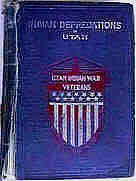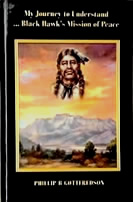
Timpanogos Chief Antonga Black Hawk
Mortally Wounded At Gravely Ford
by Peter Gottfredson author of Indian Depredations in Utah


Note: Chief Sanpitch was a Chief of the Sanpitches in southern Utah who were a band of the Timpanogos. The father of Timpanogos Chief Black Hawk, Sanpitch was being held ransom by the Mormon militia when Black Hawk was mortally wounded at Gravely Ford June 10, 1866.
Looking to the southwest, and just opposite the Gravelly Ford (Scipio, Utah) could be seen a band of Indians driving a bunch of cattle. They were evidently trying to make the ford, which if reached in time would give them the passes to the mountains on the east, and insure them with a clean get away with the stock. General Pace ordered an advance, and a distance of eight miles was made to Gravelly Ford covered under the whip. The advance guard was about two hundred yards in the lead when the point of the mountain was reached and they were permitted to pass, but when the company reached the place they were fired upon by the Indians from ambush at the close range of sixty paces. The whites were commanded to cross-fire, and the Indians were routed, but about at this time the Indians were reinforced by the band driving the cattle on the west.
A guard of Indians was left over the cattle on the west side of the river, while Indians to the number of seventy-five or eighty engaged in fighting on the east side.
The whites retreated to higher ground and made the crest of a hill serve as breast-works for them. While making this retreat, William Turnbridge was wounded in the leg just as he was mounting his mule, but when assisted in his saddle, he continued to fight.
After reaching the higher ground, the Indians surrounded the whites and began to close in on them until by command the militia began to fire by platoons; this manner of fighting proved very effective, for at every fire an Indian or his horse would drop. Then the Indians began to circle around, and when a point of advantage was gained, they fired on the whites. There was one particular point from which most of the shooting was done. A wash led in the direction of the point, and James E. Snow determined to put an end to the practice of firing from it. He followed the wash nearly to the mouth, and then dropped behind a large sage-brush, which he used for a rest to shoot from. He soon got range on an Indian who was trying to put one of his wounded, Whitehorse, on a horse. The horse being between Snow and the Indian, he could not see the body of the Indian, but judging from the position of his feet and legs, he decided that by shooting the horse through region of the heart the same shot would get the red man. The aim proved true, for at the report of the rifle the horse fell and the Indian was wounded. He was picked up by two of his braves and was spirited away.
The wounded Indian was none other than the famous Black Hawk, though at the time it was not known. Mr. Snow had a narrow escape in this affair, for he was fully 600 yards from the rest and was closely pursued by three of the enemy. While getting away from them, Snow caught his saber between his legs and fell. Four men were dispatched to rescue him and thus he was saved from the torture of the red men.
When the tide of the battle seemed turned in favor of the whites, though their ammunition by this time was exhausted, a cloud of dust from the direction of Round Valley suggested to the militia that more Indians were coming; a retreat was therefore ordered. Black Hawk's good fortune again befriended him; the approaching horsemen were a company of Fillmore Calvary, seventy strong under Captain Owens. Before they effected a junction with Gen. Pace the slippery foe were safe in their mountain fastnesses.
A month following this tradgic event, In 1866 Canute Peterson paid a visit to the ailing Timpanogos leader Black Hawk, taking gifts of sugar, hams, bread, beads, molasses, tea, coffee, tobacco, flour, medicines and clothing. It followed Black Hawk and Canute smoked the pipe of peace under an old juniper tree, now referred to as the "peace treaty tree." They agreed that they would not fight as long as water continued to run in the creek.
Antonga Black Hawk never fully recovered from his wound which eventually led to his death and was buried at Spring Lake, Utah in 1870.
Next: Timpanogos Chief Sanpitch Murdered Father of Antonga Black Hawk
|
